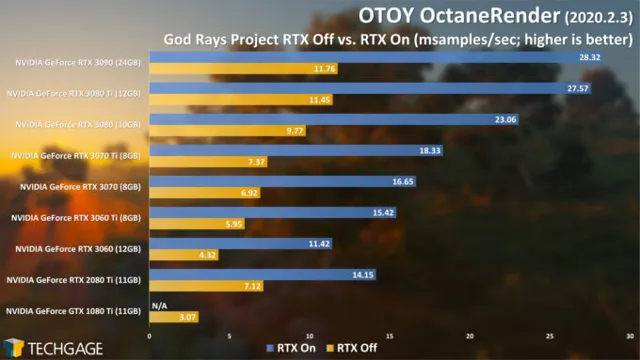If you’re passionate about 3D graphics and rendering, then the name Octane Render must be familiar to you. This powerful software helps designers and artists create stunning visuals that are incredibly realistic. But to achieve these stunning visuals, you need a graphics card that can keep up with the intensive rendering demands of Octane Render.
In this blog, we’ll explore the various graphics cards available in the market that are compatible with Octane Render. We’ll cover their features, performance, and price – all the essential factors to consider when selecting a graphics card for Octane Render. So, whether you’re a professional 3D artist or a beginner trying your hand at 3D graphics, this blog will help you make an informed decision when it comes to choosing the right graphics card for rendering with Octane Render.
Let’s dive in!
What is Octane Render?
Octane Render is a powerful GPU-based rendering software that allows for fast and realistic rendering of 3D scenes. However, it’s important to note that Octane Render requires specific graphics cards in order to function properly. Some of the supported graphics cards include the NVIDIA GTX series, as well as the NVIDIA RTX series.
These cards are able to handle the heavy computational requirements of Octane Render, making it possible to achieve high-quality results in a relatively short amount of time. It’s important to do your research before investing in a graphics card specifically for Octane Render, as compatibility is critical. With the right hardware in place, though, Octane Render can be a powerful tool for those working in 3D graphics and animation.
Description of Octane Render
Octane Render is a cutting-edge GPU-accelerated renderer that uses path tracing to produce highly realistic images with stunning accuracy and detail. It is a powerful tool used by major studios worldwide to create top-tier visual effects and animations. Octane Render’s advanced features are driven by the CUDA cores in Nvidia graphics cards, giving it unmatched speed and performance.
This renderer’s user-friendly interface and intuitive features make it a popular choice for both experienced professionals and beginners. Octane Render is famous for its easy-to-use node-based system, which allows artists to easily tweak and adjust all aspects of their scene, from textures and lighting to complex shaders and volumetric effects. It is the ultimate tool for creative professionals looking to create stunning, photorealistic 3D projects in record time.

What Graphics Cards are Supported?
If you’re considering using Octane Render, it’s important to know what graphics cards are supported. Octane works well with NVIDIA GPUs that support CUDA technology, including the GeForce GTX series and higher-end NVIDIA Quadro cards. In addition, the latest RTX series of NVIDIA GPUs are specifically designed to work with Octane and offer improved ray tracing abilities.
When it comes to AMD GPUs, Octane may work on some models, but performance may not be optimal and is not officially supported. It’s important to research and choose a compatible graphics card to maximize your Octane experience and render times. Remember to check the Octane website for up-to-date information on supported graphics cards, as new models are constantly released.
List of Supported Graphics Cards
If you’re a gamer, you know how vital it is to have a powerful, high-performance graphics card. So, what graphics cards are supported for your favorite games? There are many models available on the market, but not all graphics cards support all games. Some games may require specific features or have certain specifications that are only supported by certain graphics cards.
For example, if you’re a fan of racing games, the Nvidia GTX 1650 and AMD Radeon RX 570 are excellent choices. They are both affordable options that provide a smooth, immersive gaming experience without lag or stuttering. On the other hand, if you prefer more graphically intensive games, such as first-person shooters or RPGs, you may need a more powerful graphics card.
In this case, the Nvidia RTX 3080 or AMD Radeon RX 6800 XT are excellent choices that offer exceptional performance and support for ray tracing. It’s essential to research the specific requirements of the games you want to play and choose a graphics card that supports them. Even if you have a high-end graphics card, it may not perform optimally if it doesn’t meet the game’s specifications.
But don’t worry, there are many resources available online that can help you find the perfect graphics card for your gaming needs. So, whether you’re a casual gamer or a hardcore enthusiast, there’s a supported graphics card out there that will meet your expectations.
How to Check if Your Graphics Card is Supported?
If you’re planning on using Octane Render for your graphics, you may wonder if your graphics card is supported. The good news is that Octane Render has a list of supported graphics cards that you can easily check. To do this, head to the Octane Render website and navigate to the Support section.
From there, you can check for the list of supported graphics card models. If your graphics card isn’t on the list, unfortunately, you won’t be able to use Octane Render. However, if your graphics card is supported, you’ll be able to enjoy Octane Render’s advanced features and performance.
Overall, it’s a quick and easy process to check if your graphics card is supported for use with Octane Render.
Step-by-Step Guide
If you’re a gamer, content creator, or workstation user who wants to upgrade or build a new PC, you should know if your graphics card is compatible with your system. Before buying a new graphics card, it’s crucial to check if it’s supported by your motherboard and power supply unit to avoid compatibility issues. To do this, you need to identify the specifications of your motherboard and PSU, such as their PCIe slot version, wattage, and connectors, and compare them with your graphics card’s requirements.
You can also check the manufacturer’s website for compatibility lists or use online tools like PCPartPicker to select compatible components. Upgrading your graphics card is an excellent way to enhance your PC’s performance and enjoy more immersive and smoother gaming, video editing, or hardware-accelerated tasks. So, take some time to research and ensure that your new graphics card is supported before making the purchase.
Why is Having a Supported Graphics Card Important?
Octane Render is a powerful tool for creating stunning, photorealistic graphics and animations. However, to get the most out of it, it’s essential to have a supported graphics card. This is because Octane Render relies heavily on the power of your GPU to perform calculations and render high-quality images.
When you have a graphics card that’s optimized for Octane Render, you can work more efficiently, with faster render times and higher levels of detail. Plus, you’ll be able to take advantage of advanced features like displacement mapping and adaptive sampling. Some examples of Octane Render supported graphics cards include the Nvidia GeForce GTX series, the Titan X, and the Quadro series.
So if you’re serious about creating professional-grade graphics, investing in a supported graphics card is a must.
Improved Performance and Output Quality
Having a supported graphics card is crucial in achieving improved performance and output quality, especially when it comes to graphic-intensive tasks such as gaming, video editing, and 3D rendering. A supported graphics card ensures that your computer has the necessary hardware to process and display high-quality graphics without compromising its speed and performance. It also enables you to take advantage of advanced features and settings, such as high-resolution displays, Anti-Aliasing, and DXR Ray Tracing.
Without a supported graphics card, your computer may struggle to handle complex graphics, resulting in lag, slow render times, and poor image and video quality. Therefore, it’s important to invest in a high-quality graphics card that is supported by your computer system to help you achieve optimal performance and output quality.
Conclusion
In the world of Octane Render, having a top-notch graphics card is like having a secret superpower. The blazing speed and stunning visuals unleashed by a supported card can turn even the most mundane project into a work of art. So, if you want to take your rendering game to the next level, you better gear up with a graphics card that’s ready to roll with Octane.
After all, with great power comes great renderability!”
FAQs
What graphics cards are supported by Octane Render?
Octane Render is compatible with Nvidia graphics cards, specifically those with CUDA technology, including the GTX series, Titan series, and Quadro series.
Can I use an AMD graphics card with Octane Render?
No, Octane Render is not currently compatible with AMD graphics cards.
What is the minimum graphics card requirement for using Octane Render?
Octane Render recommends using a graphics card with at least 4GB of video memory (VRAM) for optimal performance.
How do I know if my graphics card is compatible with Octane Render?
You can check the list of officially supported graphics cards on the Octane Render website, or try using the OctaneBench tool to test your card’s compatibility.


